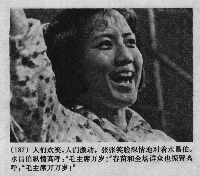 ill. 6.26 a, metadata
ill. 6.26 a, metadata
 ill. 6.26 b, metadata
ill. 6.26 b, metadata
 ill. 6.26 c, metadata
ill. 6.26 c, metadata
 ill. 6.27, metadata
ill. 6.27, metadata
 ill. 6.28, metadata
ill. 6.28, metadata
Depicting Heroes
In stark contrast with the villains, the positive characters, heroes, and especially the main heroes are, in their idealized form of the Cultural Revolution comic and in accordance with the principles of the Three Prominences, always shown in full view. They deserve many close-ups. In Spring Sprouts, three of the final four panels show the heroine Chunmiao displaying her healthy, strong, and smiling face against different backgrounds significantly tinged with elements such as fields and electricity masts, which mark progress and prosperity (ill. 6.26).
Main heroes are always depicted in bright light, with straight and strong bodies. One obvious example of this technique is seen in depictions of Jiao Yulu who, although seen at the same distance from the viewer as everyone else surrounding him, regularly appears bigger than any of the others (ill. 6.27). This technique of making heroes seem larger than life by drawing them larger in size than their entourage seems especially blatant when children as main heroes suddenly appear much bigger and stronger than their adult friends, and even more importantly, their enemies. This is the case with the little trumpeter in the 1974 comic by the same name, for example (ill. 6.28 The Little Trumpeter 小号手 Xiao haoshou), but again, it is a feature that predates the Cultural Revolution and that recurs after 1976.
Students of the comic would have it that the single frame is inconclusive by nature (Breithaupt 2002, 37). When it comes to identifying villains and heroes in Cultural Revolution comics, however, the chain of pictures following or preceding the single frame is not necessary for correct interpretation. In and of itself, each frame showing a villain or hero is an autonomous unit that tells the reader precisely what to think, whom to believe, and whom to distrust and despise. By exaggeration, the ideal version of a Cultural Revolution comic makes the single frame speak an unmistakable language: each of the panels depicting heroes and villains can stand by itself and be interpreted “correctly.” Heroes are central to the depictions: they are strong and beautiful, they are always inspired and inspiring. The hero is, more often than not, “engulfed by a collective,” not unlike the many portrayals of Mao in which he is caught in “familiar situations.” Backed by the collective, the hero belongs to others as much as to himself, and he thus becomes ever more powerful, energetic, and vigorous (Wang 1997, 130).


















































































